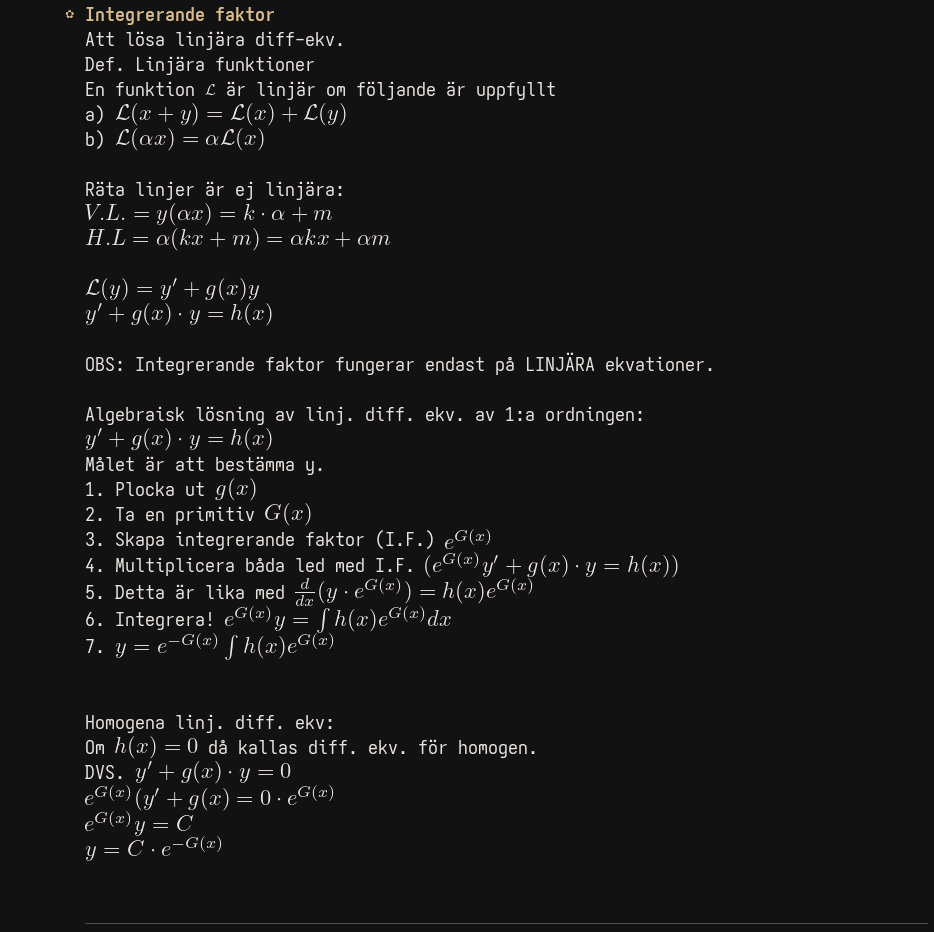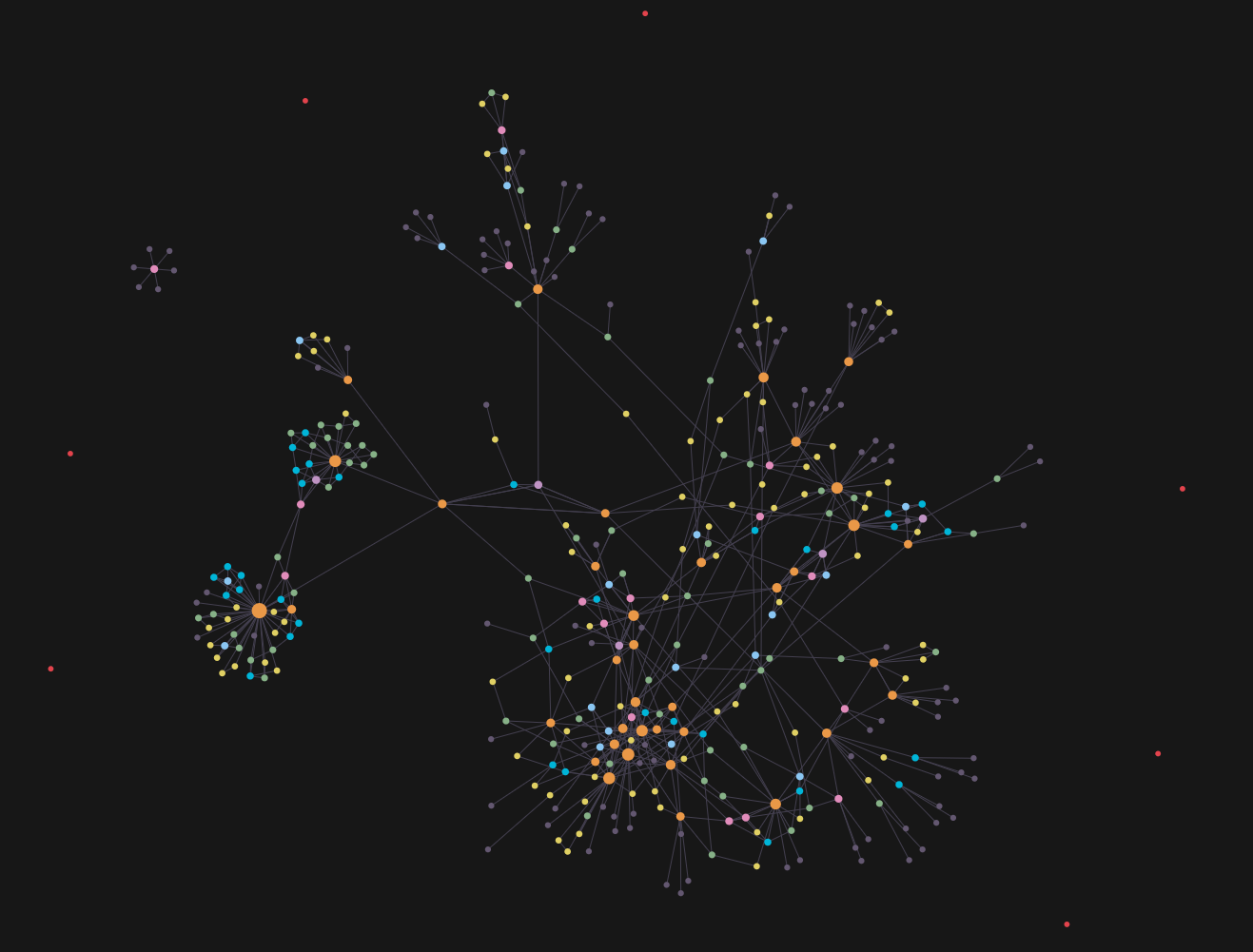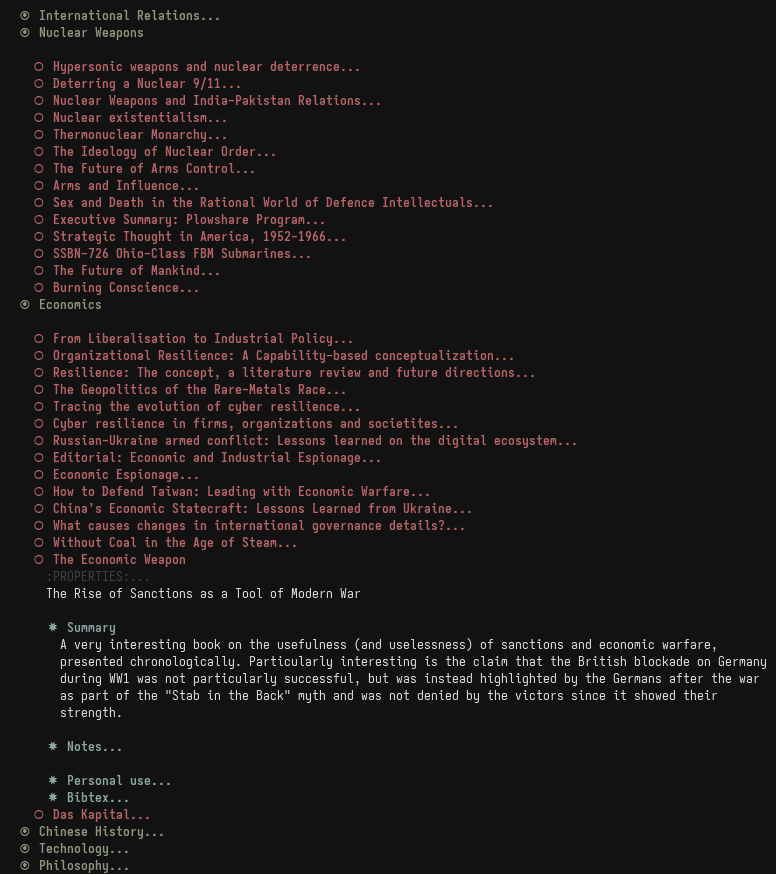Posts tagged "emacs:":
A Cohesive Note-taking and Academic Workflow in Emacs
Why Emacs?
I have been using GNU Emacs for about three years now. I initially began using it after completing a semester of introductory programming classes exclusively in GNU Nano, with a series of shell scripts to compile and run C# code, and to set up a trio of terminals; one for code editing, one for compilation, and one to actually run the CLI program I was writing. I had practically created my own little system for terminal multiplexing. This might sound like hell, and in hindsight it was. I was not even aware of some of the abilities of nano to perform syntax highlighting, display line numbers, indent lines et cetera. I merely needed something quickly to write text in, and was horrified at my classmates who had to sit idly and wait for visual studio to start or restart after crashing, it did not help that visual studio was not even available in platform of my choice. In the beginning I only needed to write short programs, simple loops, input and output and the like, and so the simplicity of nano was not in any way a burden — in some ways it was even a boon due to its quick startup time and lack of clunky UI. But eventually I found it annoying having to create and resize my layout of terminals and writing long commands to get Microsoft’s Windows-centric tooling to compile on Linux became a chore. So I created little scripts to optimize my workflow. Nothing incredibly complex mind you, just little fixes here and there. When what is called “fall break” in Sweden came around I decided to ditch Nano entirely. I had friends who used Vim, but being a staunch hipster I decided I couldn’t copy them, at least not without trying the alternatives.
And so I started out with GNU Emacs. The approach of an environment I could extend in-situ, rather than having to deal with a multitude of different tools obviously appealed to me greatly, having done so earlier using shell scripts. I completed my assignments much faster than I was expected to, and used the extra time in class to read An Introduction to Programming in Emacs Lisp from within Emacs, making me more and more inclined to extend and shape Emacs to my own needs. Eventually I found out about org-mode and started to use it for very simple notes, quickly jotting down grocery list and project outlines. The big threshold came when I discovered the in-built functionality for \(\LaTeX\) exports. I had some early encounters with latex, but most of my knowledge was limited to what it was conceptually and how to write \frac{}{}. However, the default article class that is used when exporting from org-mode looks very nice, at least compared to what I was writing in LibreOffice or Google Docs. It is of course possible to get a similar quality in output from a WYSIWYG1 editor, but the amount of time you’d have to put in to do so is much larger than simply writing the text in org-mode and pressing C-c C-e l p. This of course does not have any impact on the quality of output, but as a fan of typography I like to think that a nicely formatted document enhances ones Aristotelian ethos, in that your credibility as a writer is improved in the eyes of the reader. Emacs therefore became relevant in not just my programming classes and microcomputer classes, but also all classes that involved some sort of essay or technical writing — Swedish, English, religious studies, history, engineering, and management. But there were two main subject that took up a considerable portion of my time where I had to put my cohesive Emacs workflow aside and resort to traditional techniques: physics and mathematics.
Mathematics in Emacs
For taking notes I started out with a simple notes.org file, separating subject and topics organically with headers. I would recommend other to do the same. Initially, simply writing things down is the goal, and any optimisations will likely result in a net loss. I was inspired by Gilles Castel’s next-to famous series of blog posts on his note taking in LaTeX and vim, particularly his emphasis on “no delay [being] acceptable”. Of course, there are significant deviations in mine and Castel’s approaches and, to be perfectly honest, I think his notes are of a far superior quality. The primary difference is in medium; while the mathematics are written in latex, I prefer to write prose in the much lighter syntax of org mode or markdown, no \emph for me. Instead, I use org-latex-preview and org-fragtog to display latex inline and use the org documents themselves as notes instead of exporting them to PDF. Here is an example of a quick step-by-step way to solve first order differential equations using the integrating factor:

While Karthink has shown that you absolutely do not need to rely on writing snippets as Castel does, I still take that approach. Karthink relies heavily on auctex, an amazing suite for writing latex in Emacs, but most auctex functionality can not be used directly in org-mode. cdlatex, by the same author as org-mode, is however very useful through the org-cdlatex-mode minor mode. It allows for auto-completion of commonly written things like \(^{\text{super}}\) / \(_{\text{sub}} \text{-scripts}\) and Greek letters. It also creates a “just press tab whenever you want to continue writing” workflow that will move point in or out of delimiters and complete symbols. This combined with a liberal set of custom expanding templates using yasnippet creates a fast and coherent system since yasnippet also uses TAB as a key by default, meaning that you can spam it throughout writing, only thinking about the math conceptually as you’re listening to the lecturer.
But Emacs is not limited to writing mathematics merely in a documentary fashion, but also in a practical one. While theoretical mathematics operate on the syntax of math itself (algebraically), physics is often times interested in the actual values of the operations. For this I often quickly wrote mathematics in polish notation directly, also known as Emacs lisp. I find algebra difficult in polish notation, and so I usually do it in latex first, only performing the last numerical calculation in lisp.

This is what I would call the “killer app” of org-mode compared to other note taking applications like obsidian or pure TeX files. Being able to instantly tap into a programming language is really powerful, but it also feels very powerful, even when doing trivial things. Quickly being able to jot down numerical calculations (and having them written down for future reference) is quite useful. While I am sure one can write notes in Jupyter notebooks and other computational documents I have yet to hear of someone do this2. Emacs’ configurability means that one can easily adapt it to one’s own needs rather than either writing your own incomplete tooling or learning someone else’s workflow.
Humanities and the social sciences
After high school I have taken a break from the hard sciences and studied a few different subjects at Stockholm University and the Swedish Defence University. What strikes me as fundamentally different is that while mathematics builds on itself very clearly, where you directly use earlier knowledge to explore new topics, the social realm is a lot more “flat”. One can jump directly into Foucault’s postmodernism or Hegel’s Phenomenology and, while of course missing valuable context, still enjoy a degree of understanding. Comparatively it is quite difficult to get any sort of a grasp for quantum chromodynamics without firm knowledge of the structure of the atom. I also felt that studying depended much more on obtaining a breadth of ideas and perspectives rather than sitting down and mastering whatever new topic the lecture had covered. This then called for a radically different approach.
I ditched my former monolithic “one large file” approach and instead, somewhat reluctantly I admit, began using Org roam. I was critical toward the preaching I observed being done by users of various Zettelkästen systems and felt like the idea of a “second brain” encompassing all your knowledge were useless. Having used the system for almost a year now I still feel the same way. It is quite useful to be able to link ideas, since broad concepts and actors often show up in multiple areas3.

I also took inspiration from Gregory Stein to create an org-mode bibliography that combines notes of books and articles with their respective bibtex entries. Here I am back to the monolithic file approach, with each book or article read merely separated into different broad categories4. I have quite a backlog of saved .pdf files that I would like to convert to this new bibliography, but I do not have the time to do it all manually. To start I instead just asked an LLM to convert my hand-written citations for coursework into bibtex entries and sorted them into the file. I will let it grow organically from there.

Deliverables
Academia is in the end a forum for the exchange of new ideas, and the most efficient mode for the spread of ideas is text. While we may see some change in the structure of academic writing, particularly for those less experienced, as a result of large-scale LLM usage I doubt that text will be dethroned as the primary mode of communication for human society, but this is really a subject too deep to cover in a text about using Emacs as a student. For the time being writing reports and essays is still relevant to one’s daily life. I of course do this in org-mode, simply adding some latex headers to the document when I am done:
title: The Meiji Restoration and Modernisation of Japan subtitle: IR1.1 Seminar 1 Preparatory Assignment author: Joar von Arndt
For longer assignments I usually use a two-column layout. I tweak the values for the margins when I am done writing and ready to submit or print so that the text nicely fits the page, since I think it looks more “complete” and planned out that way. Otherwise I just write plainly in org-mode, using footnotes for citations.
Group work
I do not have a good system for incorporating this to group work, since most people do not know org-mode (or even markdown!) and collaboration in real-time can be tricky. If I worked with technically minded people I might use git, but even it requires some setup and work. Instead I use — and would recommend others do too — Typst, and its corresponding web app typst.app. It has easy collaboration, beautiful real-time previews for all users and most importantly of all, a markup that is far nicer than latex’s. I used it for my gymnasiearbete (diploma project) and found it to be a lovely experience. I would recommend anyone thinking about using overleaf or the like to instead use typst. The only reason I don’t do the same is because I still prefer the syntax-light approach of org-mode.
For presentations I am a fan of suckless’ sent, both because it places emphasis on me as the presenter but also because you can create presentations ludicrously fast. That allows me to iterate quickly and spend more time thinking about the actual content rather than fiddling with what’s going to be on the screen behind me.
Conclusion
Emacs is a tremendously useful tool, and I hope that this either serves as a motivation for beginning to use Emacs (showing of what can be done in it) or to inspire someone else to take inspiration in their own daily activities. I was prompted to writing this by Daniel Pinkston’s talk at EmacsConf 2024, and saw an earlier version of myself in him. I particularly want to emphasize that one approach does not fit all, not even when it comes to personal preference. Some lifestyles/subjects require different techniques, and so you should both experiment and iterate continuously to see what works for you. This is in-line with the Emacs philosophy of complete and instant extensibility, and so I therefore could not imagine a better platform to be writing or taking notes in.
Footnotes:
What-you-see-is-what-you-get
Are you someone who does this? Feel free to email me about this and tell me about your workflow, I am always interested in hearing how other people perform these tasks.
Like Marxism! Is there any field where there hasn’t been an attempt at the application of Marxism? There’s even Marxist mathematics.
Each entry does however have an org-id so that it can link and be linked to by other org-roam nodes.
